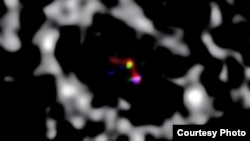Astronomers say they’ve captured the first photo of a planet being born.
Writing in the journal Nature, researchers from the University of Arizona and Sydney University in Australia say they’ve captured the new planet being formed around the young star LkCa15, some 450 light-years away.
The researchers were curious about an “inner clearing, or gap” in the protoplanetary disk circling the star. These disks contain debris left over from the formation of the star, and astronomers think planets form by “sweeping up dust and debris as the material falls onto the planets instead of staying in the disk or falling onto the star.”
"This is the first time that we’ve imaged a planet that we can say is still forming," said Stephanie Sallum, a University of Arizona graduate student.
Her colleague agreed.
"No one has successfully and unambiguously detected a forming planet before," said Kate Follette, a former University of Arizona graduate student now working at Stanford. "There have always been alternate explanations, but in this case we've taken a direct picture, and it's hard to dispute that."
Researchers said there are about 2,000 known exoplanets, but that only 10 have been photographed.
"The reason we selected this system is because it’s built around a very young star that has material left over from the star-formation process," said Follette. "It’s like a big doughnut. This system is special because it’s one of a handful of disks that has a solar-system size gap in it. And one of the ways to create that gap is to have planets forming in there."
Here's a short video about the discovery:









